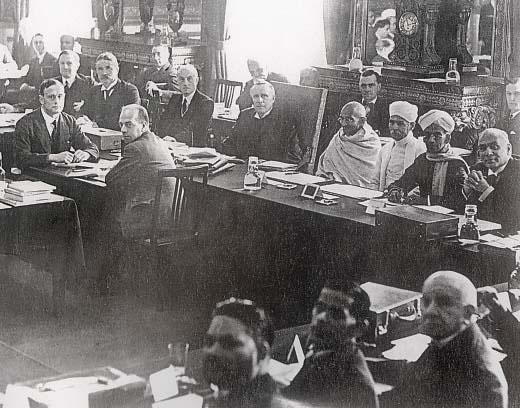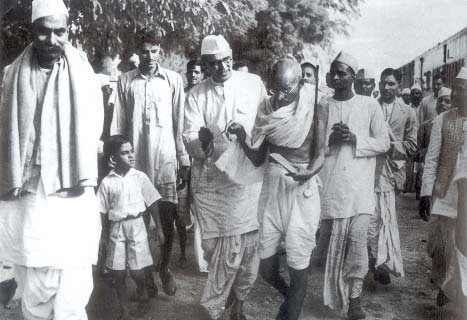Remembering Gandhi The Mahatma!!!
 |
| Mahatma Gandhi at Round Table Conference. |
In the history of nationalism a single individual is often identified with the making of a nation. Thus, for example, we associate Garibaldi with the making of Italy, George Washington with the American War of Independence, and Ho Chi Minh with the struggle to free Vietnam from colonial rule. In the same manner, Mahatma Gandhi has been regarded as the ‘Father’ of the Indian nation. He is the Legend who has not only preached about great things and noble deeds but also shown practically that they really work in the modern world. He is the One who cheers on every Rupee of Indian Currency. He may be undoubtedly the person with most number of streets named after him. Criticism will be there for everyone, even God is not spared . He definitely counts among the top of the Most influential personalities of the Century rather the Millennium.
In so far as Gandhiji was the most influential and revered of all the leaders who participated in the freedom struggle, that characterisation is not misplaced. However, like Washington or Ho Chi-Minh, Mahatma Gandhi’s political career was shaped and constrained by the society in which he lived. For individuals, even great ones, are made by history even as they make history.
Here we try to present the life of mahatama in brief.
Videos
Watch the Full Length Biopic Movie - Gandhi (1982)
Click Here to watch a Documentary on Mahatma Gandhi - "Mahatma Gandhi- The Pilgrim Of Peace"
Click Here To Watch Rare Video Footages On Indian Freedom Struggle
The Arrival of The Leader..
In January 1915, Mohandas Karamchand Gandhi returned to his homeland after two decades of residence abroad. These years had been spent for the most part in South Africa, where he went as a lawyer, and in time became a leader of the Indian community in that territory. As the historian Chandran Devanesan has remarked, South Africa was “the making of the Mahatma”. It was in South Africa that Mahatma Gandhi first forged the distinctive techniques of non-violent protest known as satyagraha, first promoted harmony between religions, and first alerted upper-caste Indians to their discriminatory treatment of low castes and women.
Among the Moderates of Indian Congress was Gandhiji’s acknowledged political mentor, Gopal Krishna Gokhale. On his advice, Gandhiji spent a year travelling around British India, getting to know the land and its peoples. His first major public appearance was at the opening of the Banaras Hindu University (BHU) in February 1916.He had been invited on account of his work in South Africa, rather than his status within India. When his turn came to speak, Gandhiji charged the Indian elite with a lack of concern for the labouring poor. The opening of the BHU, he said, was “certainly a most gorgeous show”. But he worried about the contrast between the “richly bedecked noblemen” present and “millions of the poor” Indians who were absent. Gandhiji told the privileged invitees that “there is no salvation for India unless you strip yourself of this jewellery and hold it in trust for your countrymen in India”. “There can be no spirit of selfgovernment about us,” he went on, “if we take away or allow others to take away from the peasants almost the whole of the results of their labour. Our salvation can only come through the farmer. Neither the lawyers, nor the doctors, nor the rich landlords are going to secure it.”
Gandhiji’s speech at Banaras in February 1916 was, at one level, merely a statement of fact namely, that Indian nationalism was an elite phenomenon, a creation of lawyers and doctors and landlords. But, at another level, it was also a statement of intent the first public announcement of Gandhiji’s own desire to make Indian nationalism more properly representative of the Indian people as a whole. In the last month of that year, Gandhiji was presented with an opportunity to put his precepts into practice.
Non-cooperation Movement
the Rowlatt satyagraha that made Gandhiji a truly national leader. Emboldened by its success, Gandhiji called for a campaign of “non-cooperation” with British rule. Indians who wished colonialism to end were asked to stop attending schools, colleges and law courts, and not pay taxes. In sum, they were asked to adhere to a “renunciation of (all) voluntary association with the (British) Government”. If noncooperation was effectively carried out, said Gandhiji, India would win swaraj within a year. To further broaden the struggle he had joined hands with the Khilafat Movement that sought to restore the Caliphate, a symbol of Pan-Islamism which had recently been abolished by the Turkish ruler Kemal Attaturk.
The Making Of Mahatma..
By 1922, Gandhiji had transformed Indian nationalism, thereby redeeming the promise he made in his BHU speech(The Speech - http://www.gandhi-manibhavan.org/gandhicomesalive/speech2.htm) of February 1916. It was no longer a movement of professionals and intellectuals; now, hundreds of thousands of peasants, workers and artisans also participated in it. Many of them venerated Gandhiji, referring to him as their “Mahatma”. They appreciated the fact that he dressed like them, lived like them, and spoke their language. Unlike other leaders he did not stand apart from the common folk, but empathised and even identified with them. This identification was strikingly reflected in his dress: while other nationalist leaders dressed formally, wearing a Western suit or an Indian bandgala, Gandhiji went among the people in a simple dhoti or loincloth. Meanwhile, he spent part of each day working on the charkha (spinning wheel), and encouraged other nationalists to do likewise. The act of spinning allowed Gandhiji to break the boundaries that prevailed within the traditional caste system, between mental labour and manual labour.
For several years after the Non-cooperation Movement ended, Mahatma Gandhi focused on his social reform work. In 1928, however, he began to think of re-entering politics. That year there was an all-India campaign in opposition to the all-White Simon Commission, sent from England to enquire into conditions in the colony. Gandhiji did not himself participate in this movement, although he gave it his blessings, as he also did to a peasant satyagraha in Bardoli in the same year.
The Movements
 |
| Mahatma Gandhi and Rajendra Prasad on their way to a meeting with the Viceroy, Lord Linlithgow, 13 October 1939 |
Salt Satyagraha
The Salt March was notable for at least three reasons. First, it was this event that first brought Mahatma Gandhi to world attention. The march was widely covered by the European and American press. Second, it was the first nationalist activity in which women participated in large numbers.
Quit India
After the failure of the Cripps Mission, Mahatma Gandhi decided to launch his third major movement against British rule. This was the “Quit India” campaign, which began in August 1942. Although Gandhiji was jailed at once, younger activists organised strikes and acts of sabotage all over the country.
The movement along with the Indian Army(Azad Hindu Fauz)'s Adventures and the Royal Navy Cadets mutiny, forced British to finally Quit India. The formal transfer of power was fixed for 15 August. When that day came, it was celebrated with gusto in different parts of India. In Delhi, there was “prolonged applause” when the President of the Constituent Assembly began the meeting by invoking the Father of the Nation -Mohandas Karamchand Gandhi. Outside the Assembly, the crowds shouted “Mahatma Gandhi ki jai”.
Last Heroic Days
Gandhiji had fought a lifelong battle for a free and united India; and yet, when the country was divided, he urged that the two parts respect and befriend one another. Other Indians were less forgiving. At his daily prayer meeting on the evening of 30 January, Gandhiji was shot dead by a young man. The assassin, who surrendered afterwards, was a Brahmin from Pune named Nathuram Godse, the editor of an extremist Hindu newspaper who had denounced Gandhiji as “an appeaser of Muslims”. Gandhiji’s death led to an extraordinary outpouring of grief, with rich tributes being paid to him from across the political spectrum in India, and moving appreciations coming from such international figures as George Orwell and Albert Einstein. Time magazine, which had once mocked Gandhiji’s physical size and seemingly non-rational ideas, now compared his martyrdom to that of Abraham Lincoln: it was a bigoted American who had killed Lincoln for believing that human beings were equal regardless of their race or skin colour; and it was a bigoted Hindu who had killed Gandhiji for believing that friendship was possible, indeed necessary, between Indians of different faiths. In this respect, as Time wrote, “The world knew that it had, in a sense too deep, too simple for the world to understand, connived at his (Gandhiji’s) death as it had connived at Lincoln’s.”
